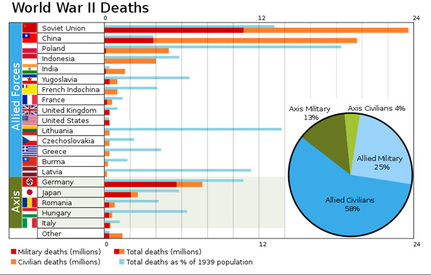Historic Context

Hitler's armies were very successful at the beginning of the war. They used the tactic of blitzkrieg (a sudden, swift, and overwhelming attack by massed armor and troops) to overrun most of Western Europe. By 1941, France, Norway, Belgium, and Luxembourg had fallen, and only Britain held out against Germany.
The British Royal Air Force succeeded in turning back the worst air raids Hitler could send against England's cities. Then Hitler ordered an invasion of the Soviet Union in June 1941. This way he brought upon himself a war in which he was fighting enemies on two fronts.
In the Far East, Japan conquered much of China, Southeast Asia, and the East Indies. On December 7, 1941, the Japanese launched a surprise attack against a United States base at Pearl Harbor, Hawaii. This action brought America into the war.
The United States fought against Japan on the Pacific Islands and in Asia, and it battled Germany in Europe and northern Africa. At the same time, the flow of United States supplies to Britain and the Soviet Union enabled those two nations to overcome the initial success of the Axis and fight back.
In november 1943, Joseph Stalin, Franklin D. Roosevelt and Winston Churchill met at Tehran Conference to plan the final strategy for the war against Nazi Germany and its allies and the chief discussion was centered on the opening of a second front in Western Europe.
By 1944, the German army had been stopped and was fighting on the defensive. In June of that year, the United States, Britain, Canada, and other Allies invaded German-occupied France in a massive attack known as D-Day. The German army, trapped between the western Allies in France and the Soviets in the east, was forced to retreat.
By the spring of 1945, Hitler's armies were driven back into Germany. Germany surrendered in May 1945. In August 1945, Japan gave up when atomic bombs were dropped on two cities, Hiroshima and Nagasaki.
When the war ended, the Allied nations united to create a new organization, the United Nations. They hoped that they could work as well together to preserve peace, as they had to win World War II. This organization is still at work today.
The British Royal Air Force succeeded in turning back the worst air raids Hitler could send against England's cities. Then Hitler ordered an invasion of the Soviet Union in June 1941. This way he brought upon himself a war in which he was fighting enemies on two fronts.
In the Far East, Japan conquered much of China, Southeast Asia, and the East Indies. On December 7, 1941, the Japanese launched a surprise attack against a United States base at Pearl Harbor, Hawaii. This action brought America into the war.
The United States fought against Japan on the Pacific Islands and in Asia, and it battled Germany in Europe and northern Africa. At the same time, the flow of United States supplies to Britain and the Soviet Union enabled those two nations to overcome the initial success of the Axis and fight back.
In november 1943, Joseph Stalin, Franklin D. Roosevelt and Winston Churchill met at Tehran Conference to plan the final strategy for the war against Nazi Germany and its allies and the chief discussion was centered on the opening of a second front in Western Europe.
By 1944, the German army had been stopped and was fighting on the defensive. In June of that year, the United States, Britain, Canada, and other Allies invaded German-occupied France in a massive attack known as D-Day. The German army, trapped between the western Allies in France and the Soviets in the east, was forced to retreat.
By the spring of 1945, Hitler's armies were driven back into Germany. Germany surrendered in May 1945. In August 1945, Japan gave up when atomic bombs were dropped on two cities, Hiroshima and Nagasaki.
When the war ended, the Allied nations united to create a new organization, the United Nations. They hoped that they could work as well together to preserve peace, as they had to win World War II. This organization is still at work today.
